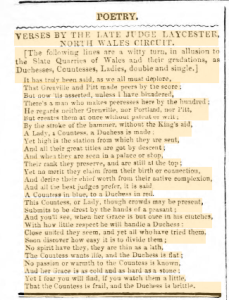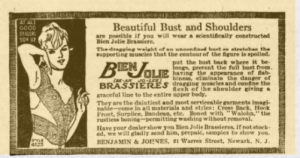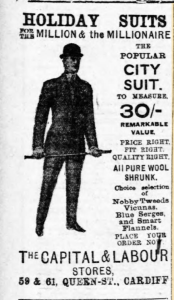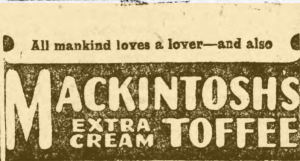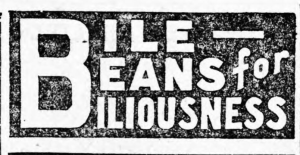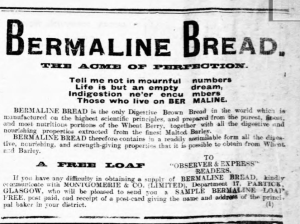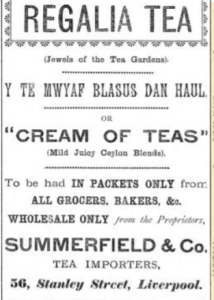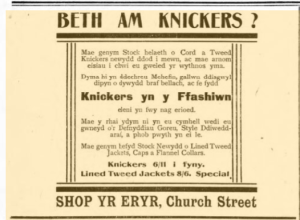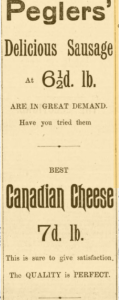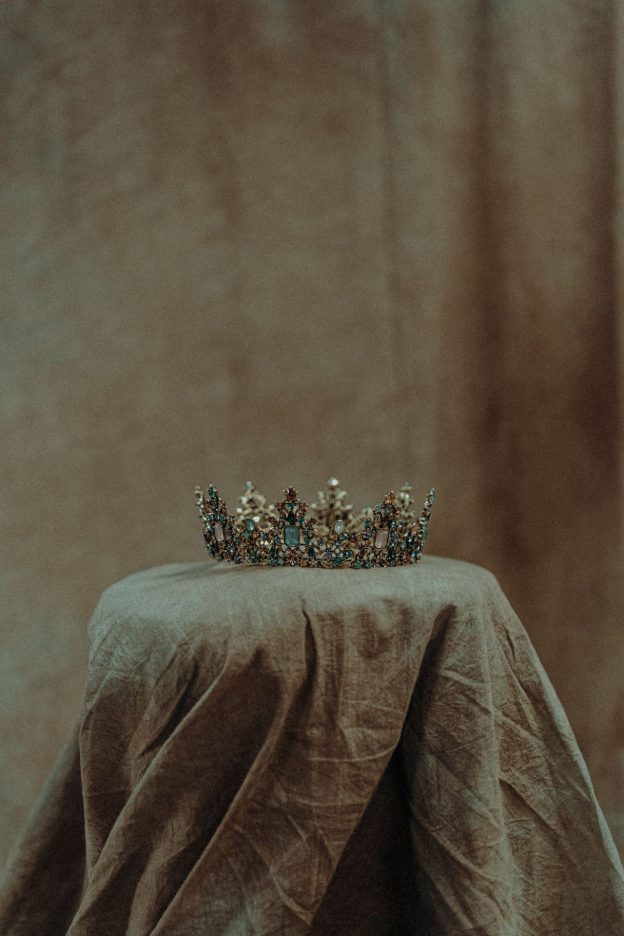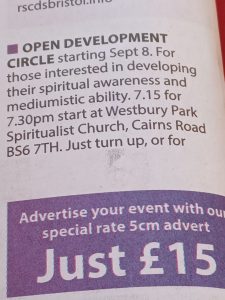For some decades before the reluctant acceptance of the first women into the legal profession in England and Wales,[i] the issue of whether or not this step should be taken was aired in many venues. The Welsh Newspaper Archive provides some interesting insights. Most of them are not particularly Welsh – and the stories are copied from national (English) and international publications. Nevertheless, it is interesting to imagine the newspaper readers of Pembrokeshire, Monmouth, Cardiff or Rhyl digesting these views and comments over their morning bara brith, laverbread etc. etc.
They were invited to consider the early efforts of women in England and Wales to be accepted as lawyers, and the comparative success of women elsewhere in this area. There is certainly some interest in ‘firsts’ and early female lawyers. Thus reports of the 1870s-1910s mention women (or, more often, ‘ladies’) becoming, or working as, lawyers in France, Belgium, Ro[u]mania, Switzerland, Scotland, Italy, Netherlands, Russia[ii], Spain, Illinois, California, New York, Idaho, Nebraska, Minnesota, Wisconsin, Connecticut, Ontario, Australia, New Zealand, Japan.
Nobody will be surprised to hear that there is a fair sprinkling of anti-women feeling. There were, for example, reports of some lovely, generous and in no way intellectually impoverished, sentiments from the Chief Justice of Australia in 1905, as the first woman barrister was admitted: ‘ladies entering the legal profession were … handicapped by nature and sex. Women were naturally more sympathetic than judicial, more emotional than logical. Besides, knowledge of the world was as essential to success at the Bar as knowledge of the law.’ A charmer, and I do like the idea that ‘the world’ is, by implication, the world of men.
As well as the predictable discriminatory nonsense, there are also some very stupid arguments – trivial reasons not to allow women to be lawyers. One 1897 writer was concerned that language would not cope with it: when the admission of women to the Paris bar was on the cards, he worried out loud that there was a problem about what to call them. Maître would not be appropriate, maîtresse would ‘grate’ and soeur would sound too much like a nun. {In the end, as fellow-fans of the marvellous Joséphine Karlsson from Engrenages/Spiral will know, they did the unthinkable and went with Maître, even if it did ‘unsex’ them – definitely not a problem for J. Karlsson …]
Oh and then there is ‘humour’ – the predictable misogynist nonsense applied to the idea of women lawyers. Somehow worse when it is thrown about in relation to a profession supposed to have rules about what constitutes evidence, isn’t it? So, they use their wiles to get ahead – up to and including marrying a client to keep him … They are evasive about their age. Yawn. They are ridiculous and insist on having the last word. They talk too much! No, they really love talking. Really – they can talk a chap to sleep! On the subject of talking too much, and thus needing to be shut up, I do find it rather telling that a 1910 report on the Divorce Commission, mentioning evidence from an eminent US lady lawyer, unnamed, about the reasons for rising divorce rates there, the report breaks off, effectively shutting her up mid-sentence, like this: ‘No longer would woman submit to the domination [Proceeding]’. Take that, you shrew! Absolutely no experience whatsoever of such treatment …
There is some more generous sentiment – e.g. approval for the hard work and perseverance of NZ first, Lucy Rebecca Benjamin, who got where she was through hard work, her family not being rich. There are positive accounts – some time afterwards – of US women lawyers. There is also what might be described as surprised approval at times. Some accounts note a woman lawyer’s appropriate conduct (such as acting with ‘due gravity’). There is certainly surprise in the account of a French ‘lady barrister’ making out ‘a good case for her client’ with a speech which was ‘both clever and practical’, and which ‘impressed’ the Court. And another French female advocate was described as ‘eloquent’, and having had a ‘triumph’ in getting her client acquitted – but the matter was surely only newsworthy because she was a woman, and thus this was surprising.[iii]
Some things phrased as praise are very much coming from a particular, narrow, view of gender appropriate behaviour. It is a positive, for example, that Myra Bradwell, Illinois legal pioneer, never allowed her lawyering ‘to conflict with the claims of her growing family.
And then there is the French story of the ‘captivating lady lawyer’ who ‘charms [an] impressionable jury’, which brings us to …
That’s all very well, but is she hot?
OK, they would not have said ‘hot’, but there is a fair amount of rather creepy and certainly belittling comment about the looks of the early female lawyers. Hard not to get pointlessly angry at it (at least in the sense that the writers in question are long gone – though maybe not, in the sense that some of these attitudes are still zombie-ing on today).
Early American female attorney, Miss Phoebe Couzins, received a particularly gushing description in 1870: she was young, ‘about 21, tall, well-formed and strikingly handsome’. And there was more. ‘Her hair of the raven hue [black – he means black] and her heavy eyebrows and lashes give force to a most intellectual face.’ The grim condescension and dreadful attempts at literary flourish continue – ‘She approached the stand with timid gracefulness that won all hearts before she said a word, and then assuming, apparently without design [oooh!] an exquisite pose, she opened her lips, and the sweet voice came ringing out like coins dropped down a many-fathomed well.’ [You what?] No need to record anything the poor woman actually said. Or if she really sounded like metal plinking and plopping into a well, possibly there was a bit of a communication issue. Do you know what, I think somebody rather fancied our Phoebe.
The ‘Roumanian’ pioneer, Mlle Bilbisco, seeking admission to the French profession was described in 1890 as having ‘a magnificent pair of dark eyes and a wide but well-formed mouth’. But this focus on her physical attributes was absolutely not gratuitous, right, because that mouth ‘enable[d] her to throw her voice to a considerable distance’.
In 1894, the sole Spanish lady lawyer who could be found, was noted ‘not only for her legal acumen, but for her great personal beauty’.
The aforementioned French captivating lady lawyer had ‘a slight feminine figure’, ‘of medium height, dark haired and dark-eyed. She has a silvery voice, and a befitting gravity of manner. … 26 … looks well in her robes … personal charm …’ And there is some treatment of her technique – ‘She has so effective a way of appeal to the sympathies that the judge … was heard to murmur “The stage has lost another Rachel in our new confre&re”. I have to say I like her bold line of argument, in defending a client up for homicide – the argument to the jury was, apparently ‘You have mothers and sisters of your own. Can you say in truth none of them has ever raised a hand against you in anger? My client’s hand had a knife in it, but that was her misfortune, not her crime.’ Hmmm. That might have required a bit of ‘sheer personal charm’ to persuade me.
And what did she wear?
The account of another early French female advocate was keen to tell us she was wearing an advocate’s gown [as opposed to? Can-can outfit]. This, perhaps, had a certain ‘wearing the trousers’ idea about it – because it was a case in which the woman was appearing with her husband, also an advocate as her junior, ‘playing second fiddle’: ‘unusual’ indeed, and probably in a rather disconcerting way.
Dress itself may be the story, as in an 1896 discussion of an American lawyer, who had spoken in court in her bonnet – her headgear being more important than her words – and the reported 1910 argument as to whether it was acceptable for a lady lawyer to wear a ‘hobble skirt’, (indeed a daft garment).
Inspiring art
There is reference to … er … art on the topic of women lawyers too. I have three exhibits for you:
- A 1906 ‘amusing sketch’, co-written by a woman, called ‘A 21st century trial’, imagining a female-dominated courtroom. Honestly, read it.
- I am taken with the idea of a courtroom drama told through the medium of silent film, as the clients of a Tonypandy cinema were treated to a film called The Weaker Sex in 1917 – which featured a woman lawyer being … good. More – being better than the boys …. And saving the day … though also with a flavour of Standing By Her Man … Really want to see this now, but can’t seem to track it down…
- Words cannot describe the awfulness of an 1895 lawyer-lady lawyer romance story. Or I cannot. Read it if you are of a stronger constitution…. Here. Bleurgh!!!
28/8/2022
GS
[i] See, e.g., this site.
[ii] And see this one.
[iii] See also this one.
Image c/o wikimedia commons



